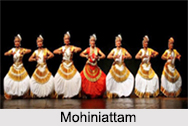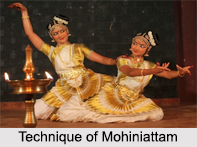 Mohiniattam is one of the major classical dance styles of India. There is a considerable amount of disagreement among scholars regarding the origin of this traditional dance form of Kerala. It has only been in recent decades that Mohiniattam has risen in popularity and acceptability. Mohiniattam though born out of the fusion of Kathakali and Bharatnatyam, has developed its own identity.
Mohiniattam is one of the major classical dance styles of India. There is a considerable amount of disagreement among scholars regarding the origin of this traditional dance form of Kerala. It has only been in recent decades that Mohiniattam has risen in popularity and acceptability. Mohiniattam though born out of the fusion of Kathakali and Bharatnatyam, has developed its own identity.
Etymology of Mohiniattam
It is said in the word Mohiniattam, `Mohini` means a maiden who charms the onlooker and `attam` means dance. The Mohiniattam dances describe episodes from the epics and legends through graceful steps, rhythmic movements of her arms and facial expressions.
Origin of Mohiniattam
The first reference to Mohiniattam is found in Vyavaharamala composed by Mazhamangalam Naryanam Namboodiri, assigned to the 16th century A.D. Most of them agree that it was during Maharaja Swathi Thirunal`s rule in the 16th century that Mohiniattam achieved its refined form. Mohiniattam is mentioned in some 18th century texts, but the practical aspect of the style was revived in the 19th century, Swathi Tirunal, the enlightened ruler of Travancore in Southern Kerala promoted its study. He composed many of the musical arrangements and vocal accompaniments, which are hymns in praise of Lord Vishnu, and provide the musical backdrop for the Mohiniattam dancers` performance.
History of Mohiniattam
Mohiniattam evolved from the state of Kerala which also has an association with the old tradition of Lasya style of dancing. The temple sculptures of the state are the earliest manifestations of Mohiniattam or other dance forms similar to it. Mohiniattam poses are also palpable from the various feminine sculptures that adorn the 11th century Vishnu temple at Trikodithanam, and the Kidangur Subramanya Temple.
The Lasya theme was incorporated by Malayalam bards and playwrights, a fact evident from the text-based records starting from the 12th century. The 16th century book titled "Vyavaharamala" written by scholar, poet, author and astrologer Mazhamangalam Narayanan Namboodiri is the first known book that mentions the term Mohiniattam in connection with a payment due to a Mohiniattam dancer. While discussing about various performing art forms of Kerala, renowned poet Kunchan Nambiar in his 17th century book "Gosha Yatra" mentioned about Mohiniattam. By that time this dance form had emerged as one of the classical art forms of the state.
Under the patronage of the princely states, the dance form of Mohiniattam developed between the period of 18th and 19th centuries but as the British colonialism spread, there was a stark decline in various classical dance forms. Eventually social and economic conditions associated with Devadasis of South India and the nautch girls of North India added with contempt and despicable attitude from the Christian missionaries and British officials, who held them as harlots, disgraced such systems. Furthermore, the Christian missionaries launched anti-dance movement in 1892 to stop such practice. They caricatured the facial expressions and sensuous gestures emoted during temples dances, which thus stigmatized all Indian classical dance forms including Mohiniattam that saw its decline in the princely states of Cochin and Travancore.
 Type and Theme of Mohiniattam
Type and Theme of Mohiniattam
Mohiniattam is also known as the `Dance of the Celestial Female Magicians`. It is essentially a solo dance, performed by female dancers. However, the basis of this dance also signifies the transformation of Lord Vishnu into a female form and showcases the concept of Ardhanarishvara, which is the combination of the male and female as one. Like many other dance forms, this was also restricted to the Devadasis. The theme of Mohiniattam is love and devotion to God. Delicate themes of love are performed with suggestive abhinaya, subtle gestures, rhythmic footwork and lilting music. Mohiniattam signifies the dance of enchanters that causes destruction of the wicked and brings delight and pleasure to the good. Unlike other classical dance forms, Mohiniattam draws upon secular and social themes rather than religious mythology, the age-old stirring tales from the Ramayana, the Mahabharata and the Indian Puranas.
Style and Technique of Mohiniattam
The distinctive style of Mohiniattam is the complete absence of heavy stamping and rhythmical tension, where the footwork is gentle, soft and sliding. The movements are never abrupt, they are dignified, easy and natural, but the vertical line of the body is never broken. Hence, among the styles detailed by Bharata Muni in the ancient Indian treatise on dance, Natyashastra, Mohiniattam resembles the Kaisiki type meaning graceful.
Performance of Mohiniattam Dancers
Mohiniattam performances depict love and devotion to God. The dancers mostly depict the verses from Meghdoot and Geeta Govinda in their dances. The spiritual essence of the ethereal love of Lord Krishna and Radha not only coloured Mohiniattam but also glorified it.
Music in Mohiniattam
The main musical instrument used in Mohiniattam is Edakka. Even the instruments such as violin, veena and mridangam provide musical accompaniment to the dancers. The vocal music for Mohiniattam is Carnatic Music. The lyrics composed by Maharaja Swathi Thirunal and Irayimman Thampi are in Manipravala, which is a mixture of Sanskrit, Tamil and Malayalam. The music also accentuates these movements by being extremely lyrical, sensuous and concentrating more on bhava than trying to articulate the swara patterns. This mode of singing is called Sopanam.
Costumes of Mohiniattam Dancers
One of the distinctive features of Mohiniattam is the simplicity of the costumes. There is a typical costume for Mohiniattam, which is a mixture of white and gold. It usually consists of a choli and a white, cream or off-white coloured Kasavu sari with a gold or red border. A pleated cloth having concentric golden or saffron coloured bands adorns the front part of the sari from the waist. This embellishment not only lets the artist perform her spectacular footwork flexibly but also highlights it, allowing the audience to watch it from a distance.
Mohiniattam Dancers
The first renowned Mohiniattam dancer was Kalyaniamma. She also taught in Shantiniketan. The other notable teachers in Kerala Kala Mandalam were Krishna Paniker and Madhavi Amma. It was from these Gurus that new generations of Mohiniattam dancers were born.




